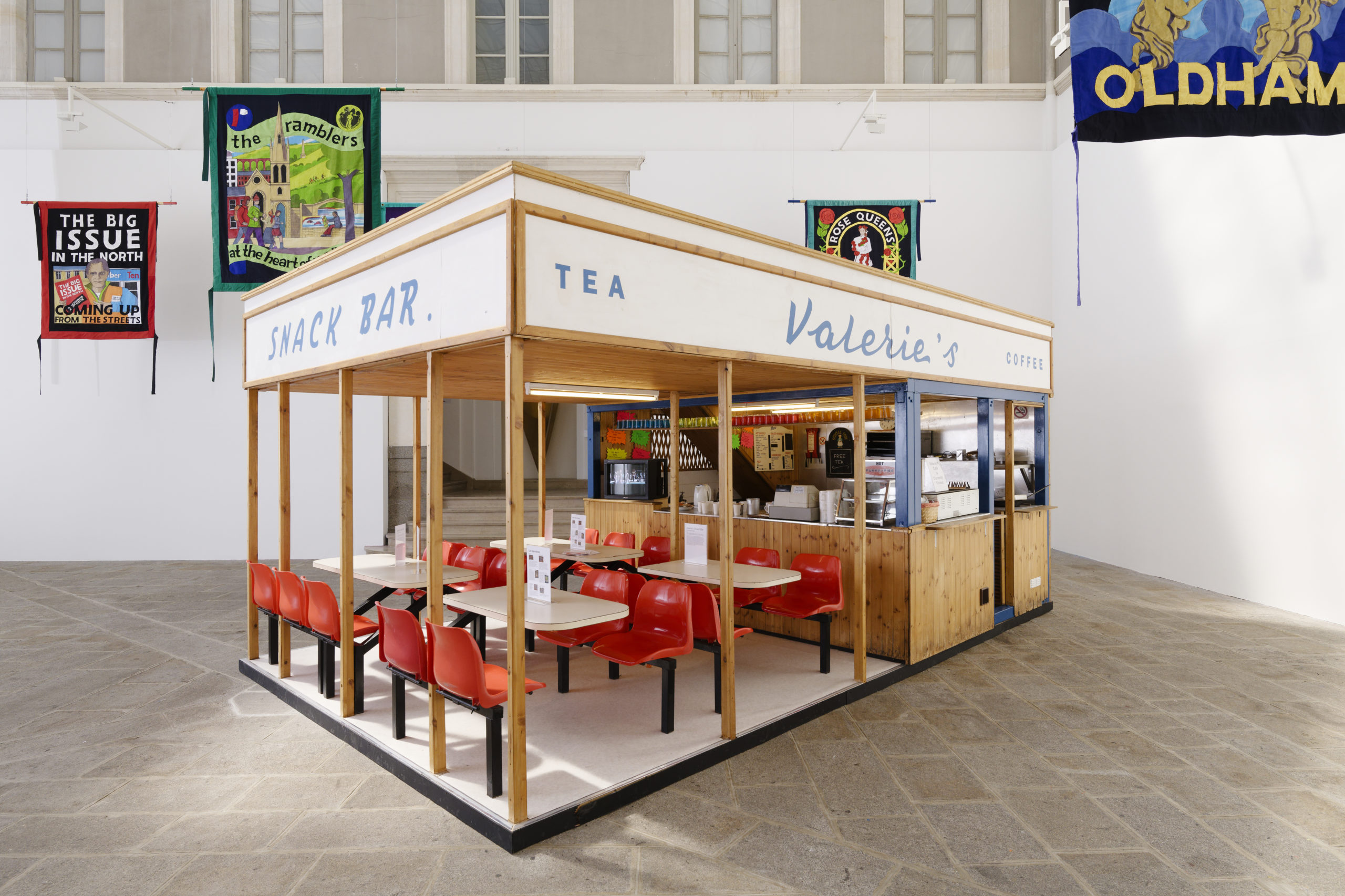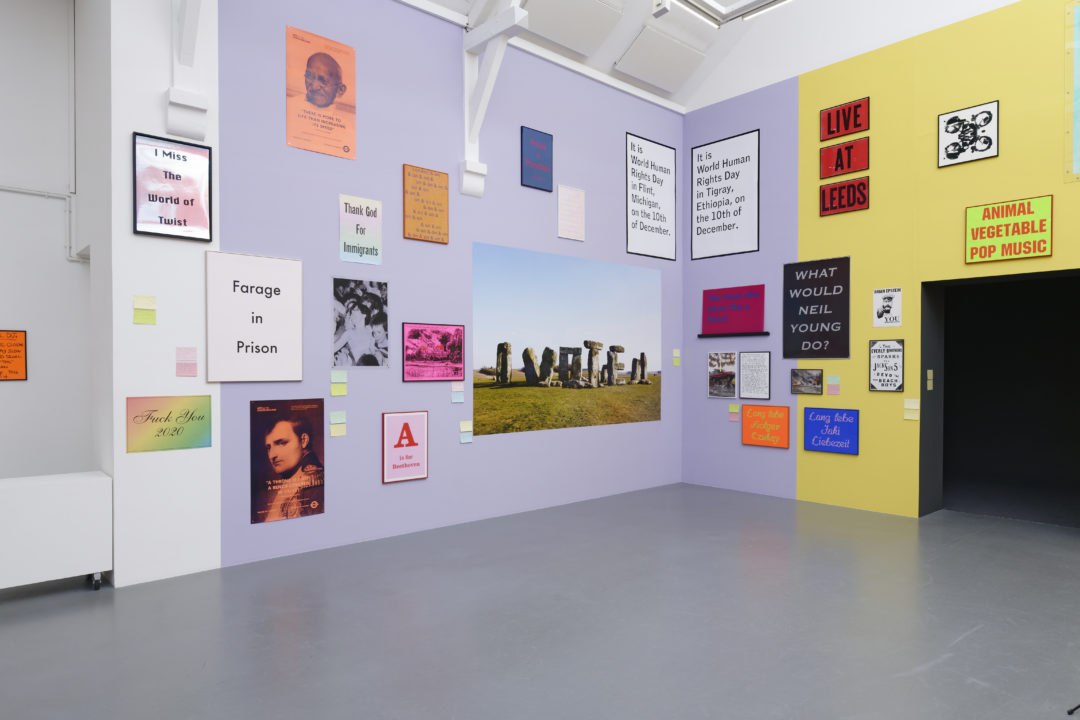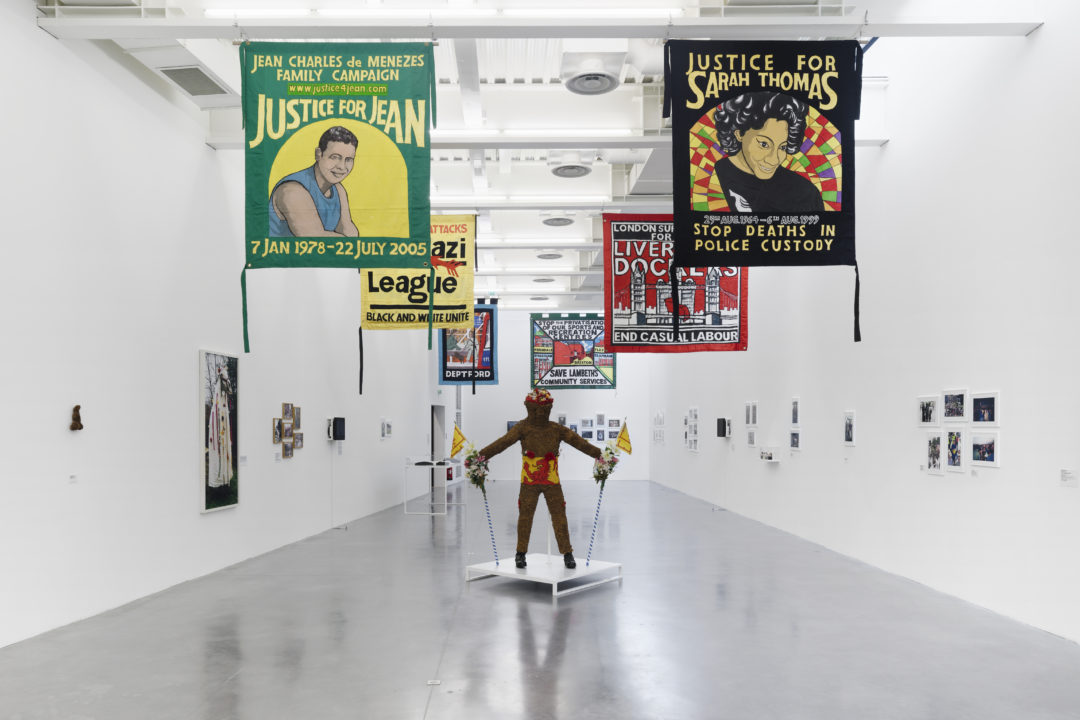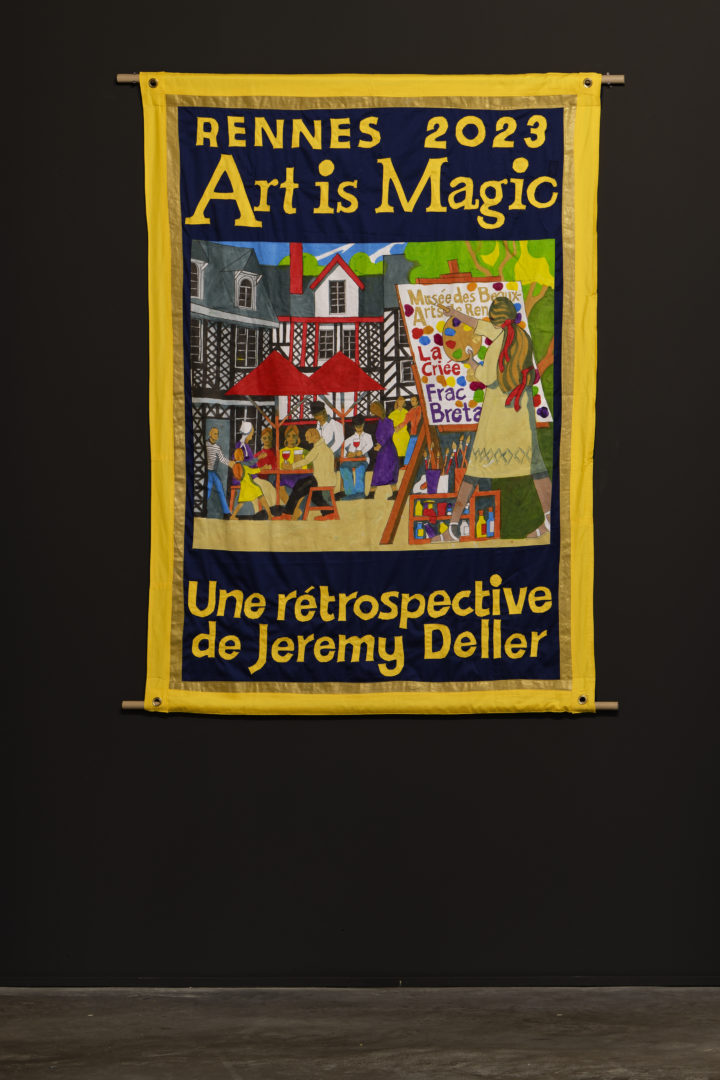Jeremy Deller at Rennes

To Investigate, Collect and Exhibit – Jeremy Deller’s Loving Gesture
According to Jean-Marie Gallais, Jeremy Deller’s practice situates itself somewhere at the crossroads between “loving gesture” and “anthropological project”, emphasising popular and fringe cultural practices which remain on the outskirts of established contemporary art and “high culture” contexts. This quintessential British artist—Deller represented Great Britain at the 2013 Venice Biennale—the artist’s composure, offbeat humour and anti-establishment stance make him an exemplary figure of a particular vision of the post-punk English scene of the 1990s and 2000s; that of the Major years, where dancing to acid house until dawn was a means of escape from the sombre reality of a post-Thatcher society which had fallen prey to industrial privatisation and unemployment, as well as to the weakening of the pound sterling. Deller’s practice undeniably represents a jubilatory celebration of resistance which affirms a variety of realities which exist outside the limits of dominant forces, projecting an acerbic vision of history, identity and British and Western current affaires.

Jeremy Deller has stated that he sees artmaking as “a form of magic which has the alchemical power to transform reality.” In his view, art can and should be carried out throughout every aspect of society, in different forms. This enchanting power resonates through the title choice for the artist’s first French retrospective exhibition, “Art is Magic”, on view this summer in Rennes. Presented in three sections, the exhibition featured a selection of works which dialogue with popular and political culture in spaces at the musée des Beaux Arts, Frac Bretagne, and La Criée Centre for Contemporary Art. My point of departure will be three chosen aspects in the work of Jeremy Deller, which in my view provide unprecedented political, cultural and artistic experiences which highlight peripheral phenomena: the production of graphic objects for display in a public setting, the collection and display of vernacular-related objects, and the reactivation of history in the face of extensive media coverage.
The installation Warning Graphic Content at La Criée Centre is composed of over 120 posters and flyers made by the artist over the last 30-something years. Through experimentation with different formats, colours and heights, the display of these elements is voluntarily undisciplined and chaotic. Graphic prints make up a large part of the Deller aesthetic. A profound desire for accessibility as well as the modest means available to the artist in the early stages of his career resulted in didactic materials produced by means of mechanical reproduction methods playing an important role. Destined for display in public spaces—at first through unofficial means in the 1990s, then by way of commissions—the posters needed to be easily understood by anyone and everyone. This form of enlarged accessibility is a means of what Benjamin Buchloh refers to as “the conditions for a collective simultaneous reception.” Deller nonetheless makes a conscious effort to push the boundaries beyond the norms of these mediums, boldly combining viewpoints with absurd content, whether poetic or polemic in nature, local or global, universal or personal. Warning Graphic Content illustrates centres of interest the artist has chosen to weave his entire oeuvre around: the importance of pop and alternative music, countercultures, the identity and current affairs of Great Britain, the rise of nationalism and its global societal implications. The diagram Acid Brass (1997) can be considered something of a manifesto. This poster takes stock of the social history of England, beginning with the bifurcations of popular music over the course of the 20th century, from brass bands to electronic music. This rhizomatic graphic illustrates the anarchistic gears operating at the heart of this visual artist’s approach.
Jeremy Deller is not an artist-maker. His conceptual aesthetic lies principally in the act of collecting. As a result, art takes on a sociological dimension through investigations conducted in the field. The creative act therefore becomes the act of selecting, transporting, inventorying, classifying, interpreting, exhibiting series of pre-existing materials. At Frac Bretagne, the renowned archival project Folk Archive can be seen in its joyous entirety. The project came about from Deller and friend Alan Kane’s interest in collecting bric-a-brac objects, in response to the exaggerated positivity of 90s Cool Britannia cultural and political phenomena. By collecting a wide variety of artefacts which are at the intersection of artistic practice and the vernacular, the duo became interested in documenting a series of popular expressions currently used at the time in Britain. There are vast arrays of these “boundary objects”, including photographs and video documentation of the Cabre Festival and the Egremont Gurning Festival, Ed Hall’s magnificent political union and British association banners, embroidered wrestler costumes, a collection of drawings made by prisoners, Peter Clara’s astonishing mechanical elephant, toys and other surprising objects. At the crux of this intellectual approach is the idea that groundswells of creativity can exist within universes which lie outside of cultural centres as well.

Collecting as creative act forms the basis for a reflexive tool for conceptual artists interested in questioning the way identities are formed, whether individual, collective, national or peripheral. It provides an opportunity for the re-evaluation of the role of creativity within society. Collections also contain an inherently critical dimension with regard to cultural institutions. Through the display of these non-artistic objects, curatorial and museographic spaces are called into question, becoming collective, living and creative instead.
The Battle of Orgreave has had substantial impact through its radical nature, establishing a place for itself within recent contemporary art history over the last 20 years. Its title refers to a historic confrontation between striking miners and law enforcement which took place on 18th June, 1984 at Orgreave, in the north of England. On this harrowing day, thousands of protesters were violently shut down. This event represented a watershed moment in the history of Great Britain as it sounded the death knell for any possible resistance of union oppositional forces against Margaret Thatcher’s authoritarian and ultra conservative government. Made in 2001 and on view at the musée de Beaux-Arts, this intermedia work is presented in three formats: a re-enactment which stages the historic confrontation, a film, co-directed by Mike Figgis for British television which documents the restaging, and a documentary and archival installation. Functioning like a kind of archival centre, the installation gathers together a selection of various documentary materials. The spectator who peruses these documents is immersed in the preparations which led up to and took place during this historic event. The making of this “monumental” work included a period of extensive research which Deller carried out through filmed interviews with key actors of the event, some of whom agreed to participate in the re-enactment of the battle, in order to relive a key moment in their lives. The artist revisits the media coverage of the event, this time giving voice to the experiences of the miners. The Battle of Orgreave combines media representation and history with a performative dimension, a notion which Anne Bénichou refers to as “a claim to replay history in order to question its process of fabrication, genealogies and the power of its representations.”
The documentary film format is a formidable way to inscribe historical processes as they are being carried out. Non-hierarchical relationships between the artist and the participants or observers of societal changes generally form the basis for these processes. The film Putin’s Happy (2019) was made during demonstrations at partisan and non-partisan political gatherings Brexit in London. The work is a painstaking study of the phenomena of radicalisation of a fringe population in England which has been afflicted by profound paranoia and conspiracy theory beliefs. Jeremy Deller interviews Brexit partisans in an attempt to understand their position. The resulting slew of nauseating racist, anti-Semitic and conspiracy theory-based rants take place in an unnerving atmosphere. Many of the shots concentrate specifically on details and codified symbols which are displayed by these extremists. There are references to the universe of football, specific passages from the Apocalpyse of St. John, to Adolf Hitler. While these attitudes take place in a British context, they are nonetheless reminiscent of anti-vax conspiracy theorists and Trump supporters, who all share similar ways of functioning. The film does give the viewer some much-needed room to breathe, however, by allowing a few pro-European people to speak—representatives of a diverse British youth which refuses to allow its future to be confiscated.
The capital of Brittany’s decision to host Jeremy Deller’s political artwork seems particularly fitting, given the artist’s dissident stance which is in synch with the city’s relative left-leaning tendencies. The multiple union banners which hang from the ceiling of the museum and the Frac, as well as the artist’s engagement with alternative music, mirror the protest movements and countercultures which have taken place over time in western Brittany. In 1997, the Rennes Rencontres Trans Musicales festival hosted members of amarching band put together for the artist’s Acid Brass project. The result was a series of brassy covers of cult favourites, a fusion of British marching band tradition and electronic music.

1 Jean-Marie Gallais, « Portrait of the artist as Folklorist», in Folklore. Artistes and Folklorists, a Chequered Past (cat. expo. Centre Pompidou-Metz, Metz / Mucem, Marseille, 2020-2021), Jean-Marie Gallais & Marie-Charlotte Calafat (dir.), Paris, La Découverte, 2020, p. 10.
2 Jeremy Deller, Art is Magic (cat. expo. musée des Beaux-Arts de Rennes, La Criée centre d’art contemporain, Frac Bretagne, Rennes, 2023), Étienne Bernard, Jean-Rock Bouiller, Sophie Kaplan, Claire Lignereux (dir.), Dijon / Rennes, Les presses du réel / musée des Beaux-Arts de Rennes, La Criée centre d’art contemporain, Frac Bretagne, 2023.
3 Benjamin Buchloh, « From Faktura to Factography » (1984), in Essais historiques, t. I : Art moderne, Villeurbanne, Art édition, coll. Textes, 1992, p. 94.
4 Pascale Trompette & Dominique Vinck, « Revisiting Boundary Objects », in Revue d’anthropologie des connaissance, n° 1, 2009, pp. 5-27.
5 Anne Bénichou, Replaying Life. Rreenactments, Cultural and Artistic Practices, Dijon, Les presses du réel, 2020, p. 59.
6 François Piron & Guillaume Désanges (dir.), Contre-vents, Paris / Saint-Nazaire, Paraguay Press / Le Grand Café – centre d’art contemporain, 2021.
______________________________________________________________________________
Head image : Jeremy Deller, Valerie’s Snack Bar, 2009 avec les banderoles de Ed Hall. Courtesy de l’artiste; The Modern Institute / Toby Webster LTD, Glasgow; Art: Concept, Paris © Jeremy Deller et Ed Hall. Exposition Art is Magic, une rétrospective de Jeremy Deller, du 10 juin au 17 septembre 2023, Musée des beaux-arts, La Criée centre d’art contemporain, Frac Bretagne, Rennes. Crédit photo : Aurélien Mole
- From the issue: 104
- Share: ,
- By the same author: To Lose Oneself Without Fear in the Works of Carla Andra, Daniel Pommereulle and Mathis Altmann at Pasquart, Gaillard & Claude: hybrid objects, fluid forms ,
Related articles
Streaming from our eyes
by Gabriela Anco
Don’t Take It Too Seriously
by Patrice Joly
Déborah Bron & Camille Sevez
by Gabriela Anco

